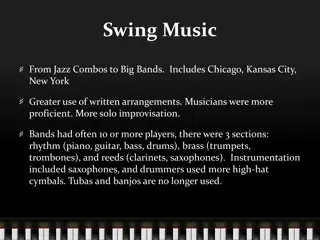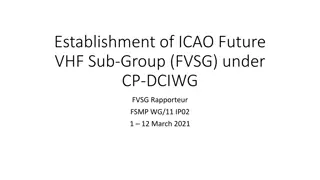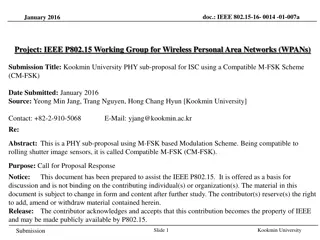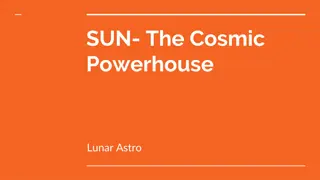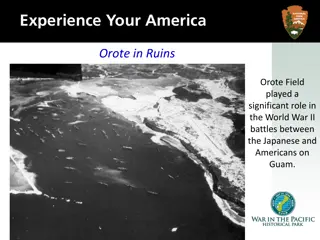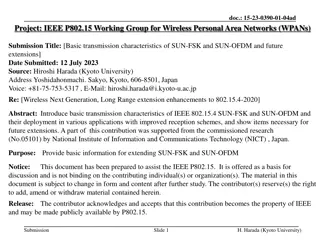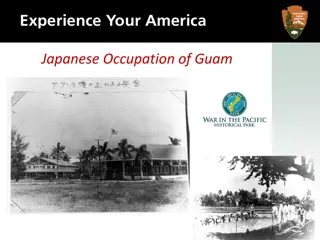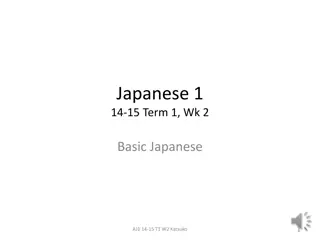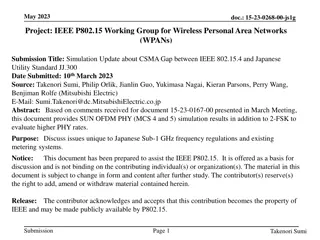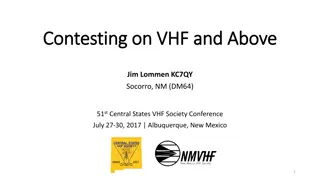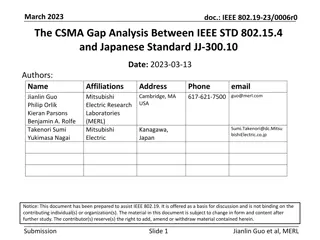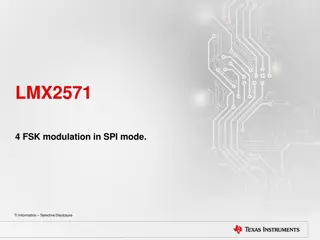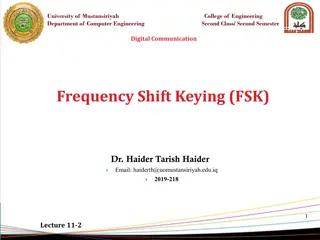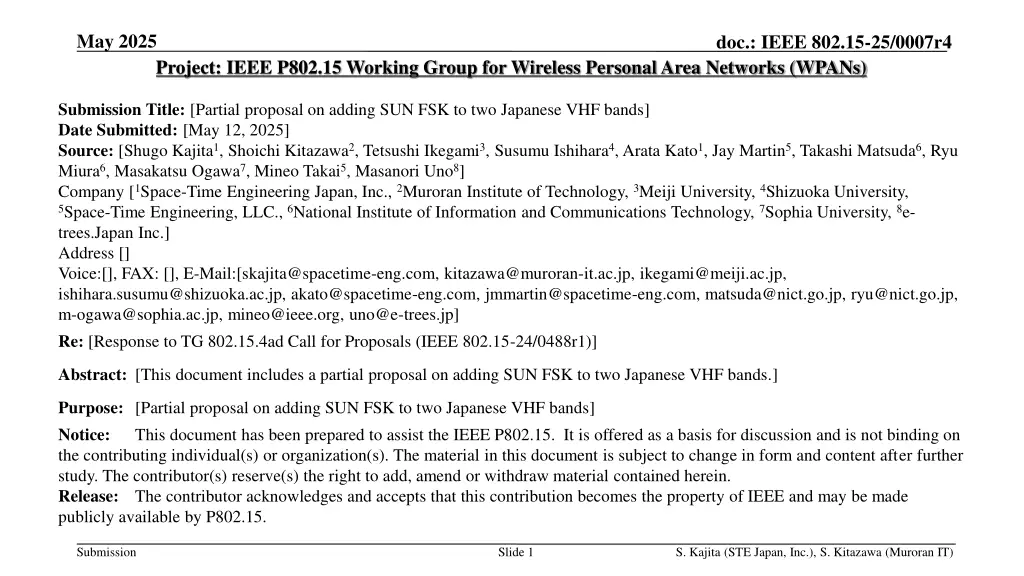
Partial Proposal for Adding SUN FSK to Japanese VHF Bands
This partial proposal aims to extend existing SUN FSK technology to two Japanese VHF bands by modifying data rates while preserving modulation parameters. The proposal aligns with IEEE standards and aims to reduce manufacturing costs by utilizing off-the-shelf radio modules.
Download Presentation

Please find below an Image/Link to download the presentation.
The content on the website is provided AS IS for your information and personal use only. It may not be sold, licensed, or shared on other websites without obtaining consent from the author. If you encounter any issues during the download, it is possible that the publisher has removed the file from their server.
You are allowed to download the files provided on this website for personal or commercial use, subject to the condition that they are used lawfully. All files are the property of their respective owners.
The content on the website is provided AS IS for your information and personal use only. It may not be sold, licensed, or shared on other websites without obtaining consent from the author.
E N D
Presentation Transcript
May 2025 doc.: IEEE 802.15-25/0007r4 Project: IEEE P802.15 Working Group for Wireless Personal Area Networks (WPANs) Submission Title: [Partial proposal on adding SUN FSK to two Japanese VHF bands] Date Submitted: [May 12, 2025] Source: [Shugo Kajita1, Shoichi Kitazawa2, Tetsushi Ikegami3, Susumu Ishihara4, Arata Kato1, Jay Martin5, Takashi Matsuda6, Ryu Miura6, Masakatsu Ogawa7, Mineo Takai5, Masanori Uno8] Company [1Space-Time Engineering Japan, Inc., 2Muroran Institute of Technology, 3Meiji University, 4Shizuoka University, 5Space-Time Engineering, LLC., 6National Institute of Information and Communications Technology, 7Sophia University, 8e- trees.Japan Inc.] Address [] Voice:[], FAX: [], E-Mail:[skajita@spacetime-eng.com, kitazawa@muroran-it.ac.jp, ikegami@meiji.ac.jp, ishihara.susumu@shizuoka.ac.jp, akato@spacetime-eng.com, jmmartin@spacetime-eng.com, matsuda@nict.go.jp, ryu@nict.go.jp, m-ogawa@sophia.ac.jp, mineo@ieee.org, uno@e-trees.jp] Re: [Response to TG 802.15.4ad Call for Proposals (IEEE 802.15-24/0488r1)] Abstract: [This document includes a partial proposal on adding SUN FSK to two Japanese VHF bands.] Purpose: [Partial proposal on adding SUN FSK to two Japanese VHF bands] Notice: This document has been prepared to assist the IEEE P802.15. It is offered as a basis for discussion and is not binding on the contributing individual(s) or organization(s). The material in this document is subject to change in form and content after further study. The contributor(s) reserve(s) the right to add, amend or withdraw material contained herein. Release: The contributor acknowledges and accepts that this contribution becomes the property of IEEE and may be made publicly available by P802.15. Submission Slide 1 S. Kajita (STE Japan, Inc.), S. Kitazawa (Muroran IT)
May 2025 doc.: IEEE 802.15-25/0007r4 Proposal Background In response to the TG 802.15.4ad Call for Proposals [1], we have developed this partial proposal aimed at extending the existing SUN FSK technology to two Japanese VHF bands where the use of SUN PHYs has not yet been defined. It aligns with the PAR s 802.15.4ad Scope of the Project statement: The amendment also defines frequency bands based on updated regional regulations. Although this is a partial proposal and does not introduce any new technology, this slide deck addresses all the Proposal Criteria outlined in the Next Generation SUN PHY Technical Guidance Document [2]. The proposal modifies only the data rates of operating modes already defined for SUN FSK in other frequency bands, while preserving all other modulation parameters. This approach: significantly reduces device manufacturing time and costs by using off-the-shelf SUN FSK radio modules that support VHF bands, and ensures that the proposed parameters are suitable for operation in the target VHF bands. Submission Slide 2 S. Kajita (STE Japan, Inc.), S. Kitazawa (Muroran IT)
May 2025 doc.: IEEE 802.15-25/0007r4 Proposal Background Our partial proposal for the VHF-High Band corresponds to the addition of existing SUN FSK parameters as outlined in the MIC document presented to IEEE 802.15 WNG (15-24/250r0). In that document, the Occupied Bandwidth shown in the draft specification table on page 10 refers to the maximum occupied bandwidth; bandwidths narrower than the channel spacing are permitted. The latest Working Group report [6] lists the data rates currently under consideration, which are collected from those defined for other frequency bands (see table below). This partial proposal aims to smooth out these data rates to better suit operation in the VHF-High Band. Data rates under consideration based on data rates defined for other frequency bands [6] concurrent use of unit channels channel spacing data rates (kbps) Submission Slide 3 S. Kajita (STE Japan, Inc.), S. Kitazawa (Muroran IT)
May 2025 doc.: IEEE 802.15-25/0007r4 Proposal Criteria: The Scope of Proposal The Scope of proposal: with reference to the PAR requirements This partial proposal aims to extend the existing SUN FSK, supported by many off-the-shelf radio modules, to two Japanese VHF bands where the use of SUN PHYs has not yet been defined. It aligns with the PAR s 802.15.4ad Scope of the Project statement: The amendment also defines frequency bands based on updated regional regulations. Submission Slide 4 S. Kajita (STE Japan, Inc.), S. Kitazawa (Muroran IT)
May 2025 doc.: IEEE 802.15-25/0007r4 Proposal Criteria: Use Cases Use cases: Provide a reference to the Use case document https://mentor.ieee.org/802.15/dcn/23/15-23-0625-10-04ad-collection-of-use-cases-for-next-gen- sun-phy.xlsx and summarize the Use cases that the proposal addresses. This proposal addresses low-speed applications in the VHF band for outdoor environments. The relevant use cases in the Collection of Use Cases for Next Generation SUN PHY [3] include: Disaster prevention monitoring Low speed Infrastructure monitoring Low speed Agriculture Low speed Fisheries Low speed Intelligent transportation systems Low speed Submission Slide 5 S. Kajita (STE Japan, Inc.), S. Kitazawa (Muroran IT)
May 2025 doc.: IEEE 802.15-25/0007r4 Proposal Criteria: Complexity and Receiver Sensitivity Complexity: The complexity should not be significantly higher compared to existing SUN PHYs. Proposals should be compatible with low-cost, low-power devices. This proposal strictly focuses on adding the existing SUN FSK technology to new frequency bands without introducing additional complexity. As a result, it remains compatible with low- cost, low-power devices. Receiver Sensitivity: if the proposal addresses the required OFDM mode specified in the PAR, then this OFDM mode shall have a sensitivity of at least -120dBm with an occupied channel bandwidth of at least 500 kHz as specified in FCC 15.247 The receiver sensitivity requirement for OFDM modes specified in the PAR does not apply to this proposal, as it focuses solely on adding FSK to the Japanese VHF band. Submission Slide 6 S. Kajita (STE Japan, Inc.), S. Kitazawa (Muroran IT)
May 2025 doc.: IEEE 802.15-25/0007r4 Proposal Criteria: Data Rate and Channel Bandwidth Data Rate: One mode with an effective payload data rate higher than of 2.4 Mbps. Proposers are encouraged to propose modes with higher data rates. This proposal does not introduce an operating mode with an effective payload data rate exceeding 2.4 Mbps. However, the proposed modes can be integrated with other proposed modes to fulfill this requirement. Channel Bandwidth: Proposers should support a minimum channel spacing of 200kHz for the OFDM modes to meet the regulation in specific regions. Proposers should support at least one mode with an occupied channel bandwidth of at least 500kHz as specified in FCC 15.247. Proposers should consider the current channel plans specified for IEEE 802.15.4 SUN PHYs. This requirement does not apply, as the proposal is limited to the two Japanese VHF bands. Submission Slide 7 S. Kajita (STE Japan, Inc.), S. Kitazawa (Muroran IT)
May 2025 doc.: IEEE 802.15-25/0007r4 Proposal Criteria: Performance Evaluation Performance Evaluation: Proposers are strongly encouraged to show simulation results for the applicable application scenarios. Channel model and interference model for simulations are described in the appendices. When performing computer simulations, the PSDU length in a packet should be 250 bytes for transmission rates faster than the current 802.15.4-2020 SUN-defined transmission rate, and 64 and 20 bytes for slower transmission rates than 50 kbit/s. The required PER should be 1% when transmitting 64 and 20 bytes for slower transmission rates than 50 kbit/s and 10% when transmitting 250 bytes for the rest of the transmission rates. Proposals should describe the on-air duration of the overall packet. Simulation results of SUN FSK in the VHF bands are presented in the Simulation section. The simulations are conducted using the AWGN channel and two channel models for frequencies below 500 MHz, as described in Annex A of the Next Generation SUN PHY Technical Guidance Document [2]. Submission Slide 8 S. Kajita (STE Japan, Inc.), S. Kitazawa (Muroran IT)
May 2025 doc.: IEEE 802.15-25/0007r4 Proposal Criteria: Mandatory and Optional Features and Forward Error Correction Mandatory and Optional Features: Proposals shall clearly stipulate the mandatory and optional behaviors/features. This proposal does not change any optional features of existing SUN FSK to mandatory. Forward Error Correction: The use of a least an optional FEC should be possible in all modes. This partial proposal does not introduce any new optional FEC. Submission Slide 9 S. Kajita (STE Japan, Inc.), S. Kitazawa (Muroran IT)
May 2025 doc.: IEEE 802.15-25/0007r4 Proposal Criteria: Modulation Modulation: The proposer should describe modulation. This proposal uses both 2-FSK and 4-FSK modulation schemes with fixed modulation indices across all data rates: 2-FSK modulation index: 0.5 4-FSK modulation index: 0.33 Symmetrical Links: It should be possible to use the same class of devices for transmit and receive. This proposal does not change the IEEE 802.15.4 MAC behaviors, where the same class of devices can be used for both transmit and receive. Submission Slide 10 S. Kajita (STE Japan, Inc.), S. Kitazawa (Muroran IT)
May 2025 doc.: IEEE 802.15-25/0007r4 Proposal Criteria: PHY Frame Structure PHY Frame Structure: The PHY should be based on the existing SUN PHY specifications. Include packet length here describe packet length vs PER for simulation and maybe other w.r.t. Use cases This proposal is based on the existing SUN FSK specifications. In SUN FSK, the total packet length consists of the PHY payload size plus 8 68 octets, depending on the preamble length. The proposal includes data rates below 50 kbps, which are typically used for applications such as GPS tracking, intermittent monitoring, and similar low data rate use cases. For these lower data rates, the packet payload size is generally only a few tens of bytes. Therefore, simulation is performed with a PSDU size of 20 bytes for data rates below 50 kbps, and 250 bytes for higher data rates. Submission Slide 11 S. Kajita (STE Japan, Inc.), S. Kitazawa (Muroran IT)
May 2025 doc.: IEEE 802.15-25/0007r4 Proposal Criteria: Symmetrical Links and Crystal Tolerance Crystal Tolerance: The PHY should support oscillator tolerances comparable to the existing SUN PHYs. This proposal does not alter the oscillator tolerance requirements specified in the existing SUN PHYs. While oscillator tolerance becomes more stringent at lower data rates, the proposed data rates are higher than those defined for SUN FSK in the 169 MHz band, which currently supports only 2.4 kbps to 9.6 kbps. Submission Slide 12 S. Kajita (STE Japan, Inc.), S. Kitazawa (Muroran IT)
May 2025 doc.: IEEE 802.15-25/0007r4 Proposal Criteria: Coexistence Features Coexistence Features: It is highly recommended that the proposer explains how interference to existing IEEE 802.15.4 networks can be avoided. This proposal targets the two Japanese VHF bands, which currently have no existing IEEE 802.15.4 networks operating. However, to improve coexistence among channels with different bandwidths within the same band, the proposed channel plans aim to minimize spectral overlap by aligning the edges of the channels, rather than their center frequencies. Channel spacing for blue channels Channel spacing for green channels Aligning center frequencies of the channels Aligning edges of the channels Submission Slide 13 S. Kajita (STE Japan, Inc.), S. Kitazawa (Muroran IT)
May 2025 doc.: IEEE 802.15-25/0007r4 Proposal Criteria: Operational Bands (1/3) Operational Bands: At least one of the operational bands relevant to the scope of the project should be supported. This proposal aims to add SUN FSK to the following Japanese VHF bands: VHF-High Band [4] 170 177.5 MHz 217.5 222 MHz Unmanned Mobile Image Transmission System (UMITS) Band [5] 169.05 169.3575 MHz 169.8075 170 MHz Submission Slide 14 S. Kajita (STE Japan, Inc.), S. Kitazawa (Muroran IT)
May 2025 doc.: IEEE 802.15-25/0007r4 Proposal Criteria: Operational Bands (2/3) The proposed operating modes for the VHF High Band are summarized below. Data rates already defined in SUN FSK for other frequency bands are shaded. Operating mode Frequency band (MHz) Parameter #1 #2 #3 #5 #7 #9 #11 Data rate (kb/s) 5 10 20 40 75 150 300 Modulation 2-FSK 2-FSK 2-FSK 2-FSK 2-FSK 2-FSK 2-FSK Modulation index 0.5 0.5 0.5 0.5 0.5 0.5 0.5 Channel spacing(kHz) 200 200 200 200 200 200 400 170 177.5 #4 #6 #8 #10 #12 217.5 222 Data rate (kb/s) 25 50 100 200 400 Modulation 4-FSK 4-FSK 4-FSK 4-FSK 4-FSK Modulation index 0.33 0.33 0.33 0.33 0.33 Channel spacing(kHz) 200 200 200 200 400 Submission Slide 15 S. Kajita (STE Japan, Inc.), S. Kitazawa (Muroran IT)
May 2025 doc.: IEEE 802.15-25/0007r4 Proposal Criteria: Operational Bands (3/3) The proposed operating modes in the UMITS Band are summarized below. Data rates already defined in SUN FSK for other frequency bands are shaded. Operating mode Frequency band (MHz) Parameter #1 #3 #5 #7 #9 #11 Data rate (kb/s) 5 10 20 40 80 120 Modulation 2-FSK 2-FSK 2-FSK 2-FSK 2-FSK 2-FSK Modulation index 0.5 0.5 0.5 0.5 0.5 0.5 Channel spacing(kHz) 100 100 100 100 200 300 169.05 169.3575 #2 #4 #6 #8 #10 #12 169.8075 170 Data rate (kb/s) 8 16 32 64 128 192 Modulation 4-FSK 4-FSK 4-FSK 4-FSK 4-FSK 4-FSK Modulation index 0.33 0.33 0.33 0.33 0.33 0.33 Channel spacing(kHz) 100 100 100 100 200 300 Submission Slide 16 S. Kajita (STE Japan, Inc.), S. Kitazawa (Muroran IT)
May 2025 doc.: IEEE 802.15-25/0007r4 Proposal Criteria: Multipath Robustness Multipath Robustness: The proposer should describe the immunity to multi-path reception. Simulation results using the Channel Model defined in Annex A are strongly encouraged. Simulation results are presented in the Simulation section towards the end of this proposal. The performance of data rates above 100 kbps (VHF-High) and 120 kbps (UMITS) degrades noticeably due to inter-symbol interference (ISI) under severe multipath conditions. This proposal targets the use of off-the-shelf SUN FSK radio modules in Japanese VHF bands, with higher data rates intended for opportunistic use in short-range communications under favorable channel conditions. The performance of these operating modes can be significantly improved using an equalizer or other implementation-dependent features at the receiver, which are out of the scope of this proposal. Submission Slide 17 S. Kajita (STE Japan, Inc.), S. Kitazawa (Muroran IT)
May 2025 doc.: IEEE 802.15-25/0007r4 Proposal Criteria: Interference Robustness Interference Robustness: The proposer should describe the immunity to interference. Simulation results using the interference model defined in Annex B are strongly encouraged. This proposal aims to add the existing SUN FSK to the two Japanese VHF bands, for which the Interference Models in Annex B [2] do not apply for the following reasons: The VHF-High Band currently has no incumbents that could interfere with the proposed radios. The UMITS Band is a licensed band with a spectrum management system in place to prevent interference with other radios. However, these VHF bands are exposed to significant man-made noise. To mitigate this, the proposal includes low data rate modes that reduce the noise power and thereby improve the SNR at the receiver, similar to the existing SUN FSK in the 169 MHz band. Submission Slide 18 S. Kajita (STE Japan, Inc.), S. Kitazawa (Muroran IT)
May 2025 doc.: IEEE 802.15-25/0007r4 Proposal Criteria: Scalability Scalability: The overall packet (including required preambles, headers, synchronization parts...) should be sufficiently scalable to cover the expected extended ranges and potential high number of nodes and interferers, while targeting the expected performance and energy efficiency. This proposal limits its scope to adding existing SUN FSK to new frequency bands and does not propose any new features specifically aimed at addressing scalability. However, it can be merged with any optional features that enhance the scalability. Submission Slide 19 S. Kajita (STE Japan, Inc.), S. Kitazawa (Muroran IT)
May 2025 doc.: IEEE 802.15-25/0007r4 Simulation: Models and Parameters Simulations are conducted with basic models provided by a commercial off-the-shelf modeling tool. Channel models AWGN channel model (baseline) Basic models provided by the tool are used as they are: frame generation, modulation, applying channel model, demodulation, and comparing output frame with input frame. Channel models for frequencies below 500 MHz [2]: COST 207 Urban and IEEE 802.22 Rural Multi-path fading based on the tapped delay line model (each line uses a stock fading module) was inserted before applying the AWGN channel model in the above code. Submission Slide 20 S. Kajita (STE Japan, Inc.), S. Kitazawa (Muroran IT)
May 2025 doc.: IEEE 802.15-25/0007r4 Simulation: Models and Parameters Radio model The FSK demodulator required a phase shift applied to the channel samples. This phase shift was static for a frame and was based on the first (data) channel sample based on the path gains output of the model. No phase tracking. Initial channel samples were skipped until the last channel model path delay was accounted for. No timing error modeling. No equalizer or inter-symbol interference (ISI) mitigation scheme modeling. Modulation parameters: Data rates in the VHF Band and the UMITS Band are shown in Proposal Criteria: Operational Bands. Gaussian Filter model with BT product of 0.5. Submission Slide 21 S. Kajita (STE Japan, Inc.), S. Kitazawa (Muroran IT)
May 2025 doc.: IEEE 802.15-25/0007r4 Simulation: Models and Parameters Performance evaluation metrics Since FSK modulation yields the same BER (and thus PER) for all data rates with respect to SNR in an AWGN channel, PER is evaluated in terms of received power (Rx power). To convert SNR to Rx power, the following formula is used: Rx Power (dBm) = 10log10(kTB) + NF + SNR (dB) k (Boltzmann constant) :1.38 x 10-23 (J/K) T (Temperature) : 290 (K) B (Bandwidth) : 1.25 x rate (bps) for 2-FSK (Hz) 1.00 x rate (bps) for 4-FSK (Hz) NF (Noise Figure) : 8 (dB) Submission Slide 22 S. Kajita (STE Japan, Inc.), S. Kitazawa (Muroran IT)
May 2025 doc.: IEEE 802.15-25/0007r4 Simulation: Results with AWGN Channel (VHF-High) Data rates slower than 50 kbps are simulated using a 20-byte packet payload. Rx power is increased until the packet error rate (PER) falls below 1%. For higher data rates, a 250-byte packet payload is used, and Rx power is increased until the PER drops below 10%. The chart on the right shows the PER performance in the VHF-High Band, with nearly identical results observed in the UMITS Band. Submission Slide 23 S. Kajita (STE Japan, Inc.), S. Kitazawa (Muroran IT)
May 2025 doc.: IEEE 802.15-25/0007r4 Simulation: Results with COST 207 Urban (VHF-High) Compared to the results in the AWGN channel, the PER performance across all data rates degrades significantly in multipath environments. An additional 21 dB of Rx power is required for 20 kbps to achieve a PER < 1%. 200 kbps and higher rates have a PER floor and cannot not achieve the PER < 10% without having an ISI mitigation scheme with COST 207 Urban. Submission Slide 24 S. Kajita (STE Japan, Inc.), S. Kitazawa (Muroran IT)
May 2025 doc.: IEEE 802.15-25/0007r4 Simulation: Results with IEEE 802.22 Rural (VHF-High) For the IEEE 802.22 Rural channel, the PER performance across higher data rates is significantly worse compared to COST 207 Urban. 100 kbps and higher rates have a PER floor and cannot not achieve the PER < 10% without having an ISI mitigation scheme with IEEE 802.22 Rural. Submission Slide 25 S. Kajita (STE Japan, Inc.), S. Kitazawa (Muroran IT)
May 2025 doc.: IEEE 802.15-25/0007r4 Simulation: Results in the UMITS Band The PER performance of the proposed SUN FSK in the UMITS Band is shown in the figures below (COST 207 Urban on the left, IEEE 802.22 Rural on the right). At 192 kbps with COST 207 Urban, and at 120 kbps and higher rates with IEEE 802.22 Rural, the PER cannot not achieve < 10% without implementing an ISI mitigation scheme. Submission Slide 26 S. Kajita (STE Japan, Inc.), S. Kitazawa (Muroran IT)
May 2025 doc.: IEEE 802.15-25/0007r4 References [1] P. Beecher, TG 802.15.4ad Call for Proposals, IEEE 802.15-24/0488r1. [2] J. Robert, P. Beecher, H. Harada, Next Generation SUN PHY Technical Guidance Document, IEEE 802.15-24/0061r16. [3] J. Robert, Collection of Use Cases for Next Generation SUN PHY, IEEE 802.15-23/0625r10. [4] Ministry of Internal Affairs and Communications, Consultation on the regulatory rules of the VHF-High Band, (Japanese). [5] Information and Communications Council, Report on the regulatory rules of the 169 MHz band systems, (Japanese). [6] Information and Communications Council, Sixth Working Group Report, April 23, 2025 (Japanese). Submission Slide 27 S. Kajita (STE Japan, Inc.), S. Kitazawa (Muroran IT)






